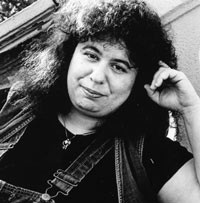


“It was Andrea’s take-no-prisoners attitude toward patriarchy that I always liked the best. The writer Susie Bright, who opposed Dworkin’s general view of sexuality but who had experienced the power of her writing, would remember after Dworkin’s death: Her dystopian vision of a women’s experience dominated at all times by male violence, or the fear of it, could feel like a bold stance against feel-good corporate feminism, especially in the absence of a dynamic left. Not coincidentally, Dworkin’s influence grew as the backlash against feminism took hold in the eighties, when the utopian visions of the whirlwind period lost their persuasive power. By the time Woman Hating, her first nonfiction book, came out in 1974, the wave of early victories and organizing had receded. Radical and even eccentric books like Shulamith Firestone’s The Dialectic of Sex and Kate Millett’s Sexual Politics became unlikely best sellers, and hundreds of small newspapers, newsletters, and pamphlets helped spread ideas unheard of just a few years earlier.īy her own account, Andrea Dworkin, who died in 2005 and who has received fresh attention following the publication of the collection Last Days at Hot Slit, spent these heady years largely in desperate isolation.

Women picketed targets ranging from universities to the floor of the stock exchange, from the New York bridal fair and Miss America pageant to the office of the Ladies Home Journal and legislative hearings about abortion. Review of Last Days at Hot Slit: The Radical Feminism of Andrea Dworkin, edited by Johanna Fateman and Amy Scholder (MIT Press, 2019).īetween 19, the radical feminist movement broke through across US culture and politics, engaging in a whirlwind of direct actions, commanding attention that frightened the powers that be, and winning a series of improbable victories.


 0 kommentar(er)
0 kommentar(er)
